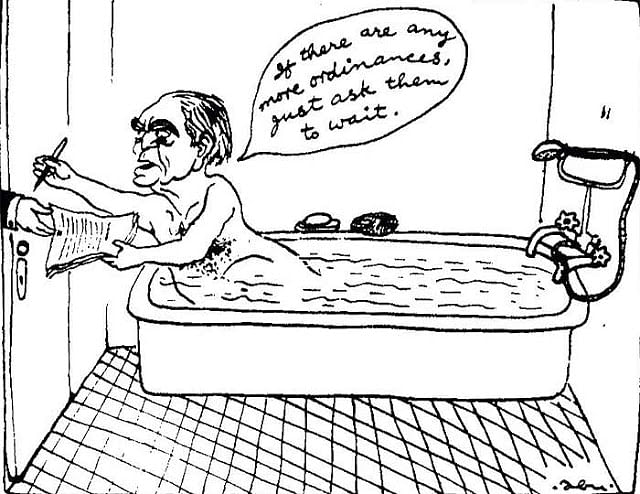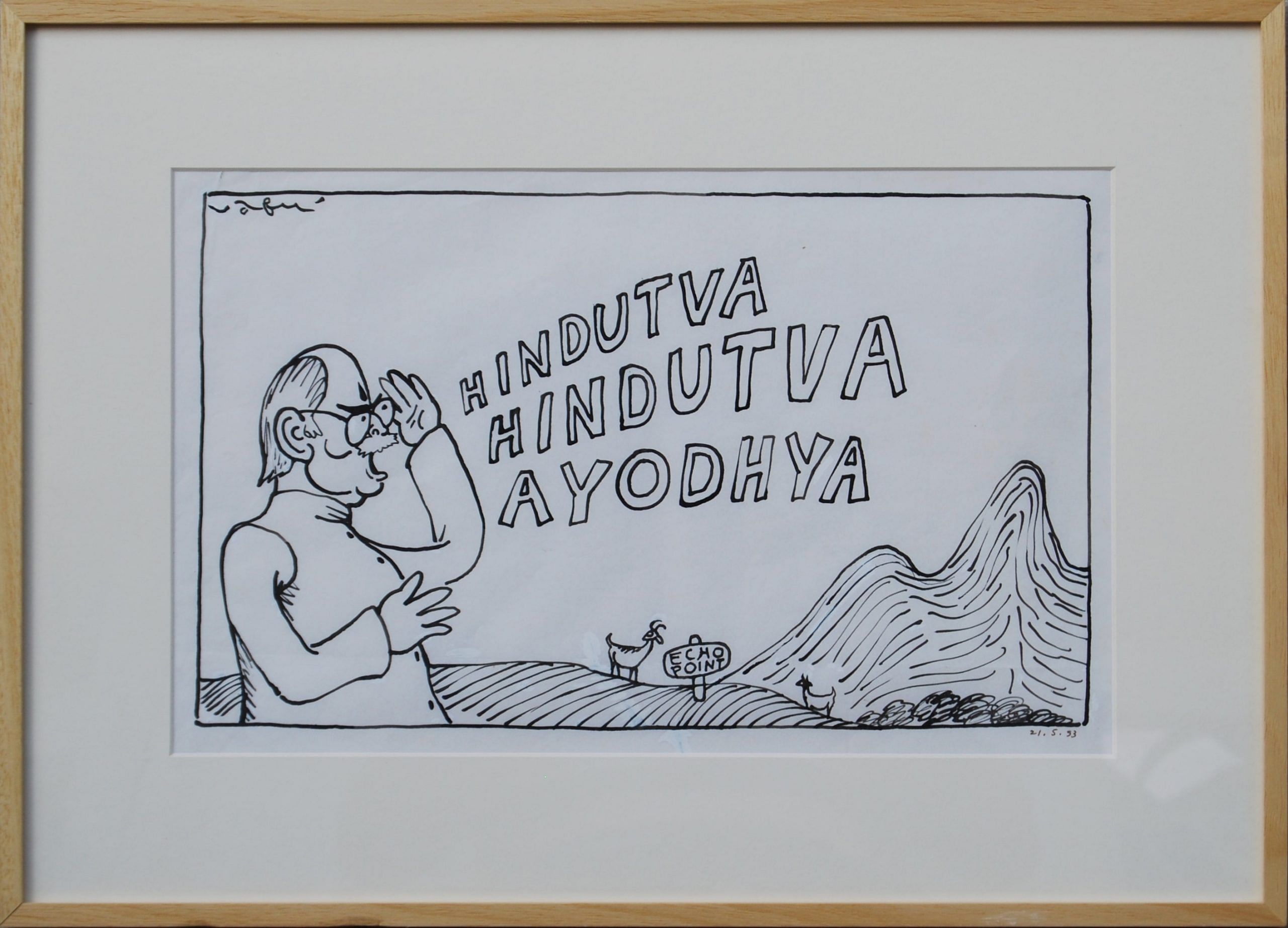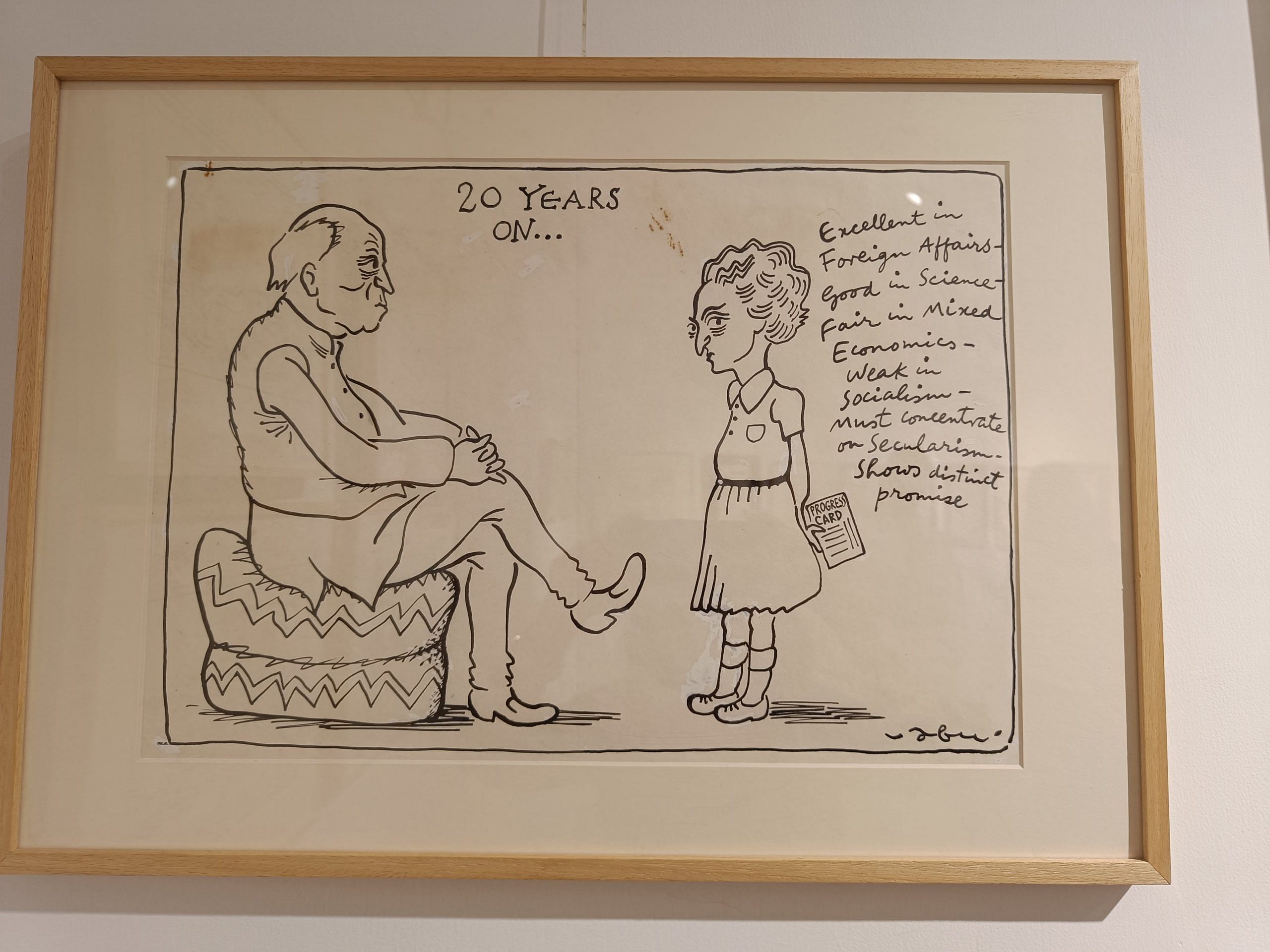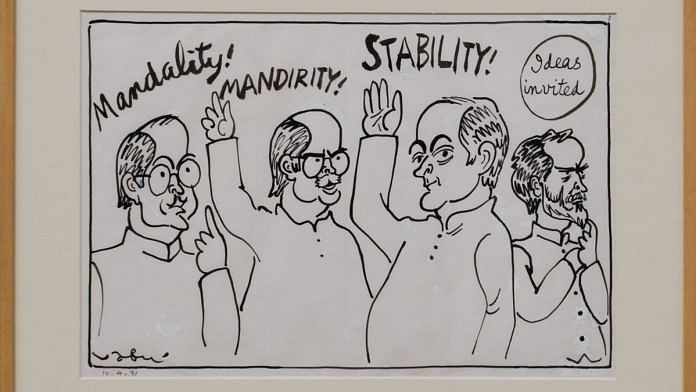Kolkata: Two bespectacled wily politicians in typical ‘neta’ attire—one dhoti clad and the other wearing a kurta—walk down the steps of a legislative assembly when one of them asks, “You think price rise will dominate the Winter Session?” The other quips, “Yes, price of MLAs.”
The black ink pen drawing could easily be mistaken as a biting commentary on contemporary politics. Its creator, the inimitable political cartoonist Abu Abraham, had a knack for sensing the political pulse so accurately that his three-decade-old cartoon appears relevant even today. Be it the fierce debates over Emergency in its 50th year or the communal unrest spawned by Hindutva and the Ram Mandir movement in Ayodhya, it all acquires greater significance when seen through the prism of Abu’s political commentary and brush strokes.
An exhaustive exhibition showcasing 265 of his works titled ‘The World Through Abu’s Eyes: A Centennial Celebration’ is being held at Kolkata’s Gallery Rasa until 21 July. The exhibition commemorates Attupurathu Mathew Abraham or Abu Abraham’s birth centenary (1924-2002) and has been curated from the collection of his daughters, Ayisha and Janaki Abraham.
Witty, critical, and humane
Spanning the critical years from the 1950s to the 1990s, Abu’s cartoons reflect the significant social and political events in India and the world. His observation and commentary, while being witty, satirical and ironic, also appear to be imbued with an innate humanity. It is almost as if Abu, the political cartoonist, had achieved the impossible feat of laughing at the foibles of the rich and powerful while unhesitatingly attacking politicians when they worked against people’s welfare.
Abu’s iconic bathtub cartoon of the Emergency imposed by Indira Gandhi in 1975 occupies pride of place at the exhibition. Encountering the original work portraying then-President Fakhruddin Ali Ahmed signing the Ordinance from his bathtub reveals Abu’s disdain for the flippant manner in which the draconian Emergency was imposed. Incidentally, this cartoon was viral on X recently, when the Narendra Modi government and the Congress-led Opposition traded barbs in Parliament over the Emergency and attacks on the Constitution.

Abu’s scathing criticism of the censorship on the press and on free speech during those years resulted in some of his cartoons being red inked by the censors who deemed it “not to be published.” A close look at one such cartoon for The Indian Express’ ‘Private View’ column dated 3 July 1975 gives a rare glimpse of the signature of the censor, DK Baisantry. He decided within a ten-minute window to axe the cartoon. It depicted a newspaper stand with an Indian Express poster stating ‘All the News That’s Fit to Print.’ The seemingly innocuous statement obviously didn’t pass the muster of the censors.

These editorial cartoons encapsulate more effectively what took newspapers several columns of written text. To depict the shenanigans of politicians, Abu devised two stock characters–one short and rotund and the other skinny and tall. In one of the umpteen cartoons featuring the duo in ‘Private View’, they are standing in front of a Uttar Pradesh poll ballot box. Pasted on the polling booth wall is a signage that says, “Vote your caste here”. The superb wordplay in the specific context of Uttar Pradesh is reflective of Abu’s witty political commentary.
Giving an insight into his creative genius, his daughter Ayisha, an artist herself, recalled, “Apart from reading the daily newspapers from 7 am to 10 am, Abu’s research at times extended to being in-situ. He would attend Parliament sessions, sitting and observing from the Visitor’s gallery.” Ayisha said politics was avidly discussed and encouraged at the dining table.
Also read: Personal is Political—Ex-IAS officer Aruna Roy wants to provoke conversations with her memoir
Abu’s experiments with cartoon
Abu’s sparse, black ink strokes and lines aptly capture the essence of the times. When viewers look at these cartoons today, they do so from the hindsight of current events and try to connect the dots to their origins in the past. One derives a greater understanding of the factious debates on Hindutva of late, when gazing at Abu’s caricature of BJP patriarch LK Advani, standing at ‘Echo Point’ and shouting out “Hindutva, Hindutva” and the reverb that follows, “Ayodhya”. The Hindutva politics that Advani ushered in then culminated in the inauguration of the Ram Mandir in Ayodhya earlier this year.

Abu’s caricatures adroitly held up a mirror to the leading politicians of that time. The curator of the exhibition, Siddharth Sivakumar, juxtaposed Abu’s cartoon of LK Advani with that of maverick Sanjay Gandhi to great effect. Sanjay Gandhi is portrayed earnestly penning the first chapter of ‘The Story of My Experiments with Youth’. In the cartoon placed next to it, more than a decade later, Advani is depicted stooped over a desk, writing the first chapter of ‘The story of My Experiments with Trishul’. A trishul (trident) is significantly placed at the back of the room. Abu succeeds in scoffing at the two politicians by alluding to MK Gandhi’s profound work ‘The Story of My Experiments with Truth’. He also presciently hints at the terrors that unfolded after their respective “experiments” were unleashed.
The politician that Abu succeeded in veritably distilling the essence of was Indira Gandhi. Through the displayed works, one can trace Abu’s evolution of the portrayal of Indira Gandhi from initial admiration to incisive satire. Her authoritarian zeal as the Prime Minister, be it in handling state governments or the Emergency, is satirised.
Like other cartoonists, Abu caricatured Gandhi’s prominent nose, but he also managed to put his finger on the essence of her personality by exaggerating her eyes. One of the cartoons shows a contemplative but slightly guilty Indira Gandhi standing before her father, Jawaharlal Nehru, with a progress card in her hand, her eyes looking out at viewers, seeking their approval. Abu also often used the metaphor of the mirror as a looking glass peering into his subject’s inner self.

Incidentally, Abu was not a trained artist. He started his journalistic career as a crime reporter in The Bombay Chronicle in the 1950s. It was his stint under the eminent cartoonist Keshav Shankar Pillai in Delhi, who founded the ‘Shankar’s Weekly’ magazine, where he honed his skills.
His ostensibly simple pen sketches were achieved after hours of observation. For instance, he attended several All India Congress Committee sessions. The 1974 session inspired his now famous sketch of a bespectacled Indira Gandhi perched purposefully on a bolster, busy poring through files.
Another such portrait on view is that of then-West Bengal Chief Minister and Communist leader Jyoti Basu in 1987. Of special interest to viewers in Bengal is the section of cartoons lampooning the Communists and their political seesaws with capitalism. A pragmatic Jyoti Basu negotiating with a more dogmatic EMS Namboodiripad. Equally interesting is the series of cartoons almost documenting the behind-the-scenes political and military machinations that went into the creation of Bangladesh.
Also read: Majha House—a cultural home for writers, artists is crafting a counter to Punjabi stereotypes
A global cartoonist
Abu was probably the only cartoonist to have made his mark abroad in leading newspapers in the United Kingdom before returning to India in 1969. This explains his global outlook and his command over international politics. He was the first political cartoonist for The Observer and thereafter at The Guardian. Several of his works from the decade he spent in the UK are on display, like the cartoon on Hyde Park Democracy, which reveals his mastery of the very British wry sense of humour.
A glimpse into his prolific output chronicling the Cold War era is visible too. Abu’s searing irony depicting the American and Soviet leaderships releasing peace doves, while on the side continuing to supply ‘US Arms for Israel’ and ‘Soviet Arms for Arabs’ is brilliant. In another cartoon, he equally castigated American capitalism and then-US President Ronald Reagan’s foreign policy, showing ‘Reagan’s Supermarket’ where military generals load their shopping carts with warheads aplenty.
It is not the cartoons alone that crystallise Abu’s genius. Little-known sketches from his extensive travels to Cuba, Palestine, and Vietnam have been exhibited here. From attending Nazi war trials in Israel to nightclubs in Cuba with Fidel Castro, Abu’s arc and life were rich and varied.
What made Abu stand out among other cartoonists was his diverse creative expressions. Apart from being a cartoonist who also sketched, he wrote newspaper columns, made a short film—No Arks (1969)—and edited The Penguin Book of Indian Cartoons.
In Abu’s own words, “You [cartoonists] have to have some radical thinking. But if you are for the status quo, what is the point in drawing?” According to Abu’s daughter Ayisha, through this centennial exhibition, they intended to acquaint people, especially educate the youth with a visual culture epitomised in Abu’s cartoons. His works critique his times and thereby history.
(Edited by Aamaan Alam Khan)






